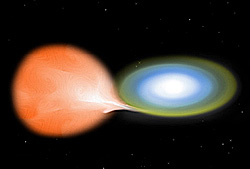Nova
Nova refers to a transient astronomical event that involves a sudden, dramatic increase in brightness of a star. This increase is caused by the accretion of hydrogen onto the surface of a white dwarf from a binary companion, which ignites in a runaway nuclear fusion reaction. Novae are considered to be a cataclysmic variable star phenomenon, distinct from supernovae, which are much more energetic events.
Overview[edit | edit source]
A nova occurs in a binary star system where one of the stars is a white dwarf, an extremely dense remnant of a star that has exhausted its nuclear fuel. The companion star can be a main sequence star, a subgiant, or a red giant. If the two stars are close enough, material, primarily hydrogen, can be pulled from the companion star's outer layers onto the white dwarf's surface. As this material accumulates, pressure and temperature increase until the hydrogen undergoes nuclear fusion in a runaway reaction, causing a rapid and vast increase in brightness. The brightness of a nova can increase by a factor of thousands to hundreds of thousands, making the star temporarily visible to the naked eye.
Classification[edit | edit source]
Novae are classified into several types based on their light curve characteristics and the spectra they emit. The main types are:
- Classical Novae (CN): These are systems that have been observed to undergo a nova event once. After the event, the brightness diminishes over weeks to months, and they return to their pre-nova state.
- Recurrent Novae (RN): These systems have been observed to experience multiple nova eruptions. The intervals between these eruptions can range from a decade to a century.
- Dwarf Novae: Unlike classical and recurrent novae, dwarf novae do not involve a thermonuclear runaway. Instead, their outbursts are caused by instabilities in the accretion disk around the white dwarf.
Observation and Research[edit | edit source]
The study of novae involves observing their light curves (the graph of light intensity over time) and their spectra. This research helps astronomers understand the processes of mass transfer in binary systems, the behavior of accretion disks, and the conditions that lead to thermonuclear runaways. Novae have been observed in various wavelengths, from radio to gamma rays, providing insights into the mechanisms of the explosion and the subsequent expansion of the ejected material.
Significance[edit | edit source]
Novae serve as important tools in astrophysics for several reasons. They are used to measure distances in the universe, study the interstellar medium, and understand stellar evolution and binary star dynamics. The material ejected by novae contributes to the chemical enrichment of the interstellar medium, adding elements such as helium, carbon, nitrogen, and oxygen, which are crucial for the formation of new stars and planetary systems.
See Also[edit | edit source]
Search WikiMD
Ad.Tired of being Overweight? Try W8MD's physician weight loss program.
Semaglutide (Ozempic / Wegovy and Tirzepatide (Mounjaro / Zepbound) available.
Advertise on WikiMD
|
WikiMD's Wellness Encyclopedia |
| Let Food Be Thy Medicine Medicine Thy Food - Hippocrates |
Translate this page: - East Asian
中文,
日本,
한국어,
South Asian
हिन्दी,
தமிழ்,
తెలుగు,
Urdu,
ಕನ್ನಡ,
Southeast Asian
Indonesian,
Vietnamese,
Thai,
မြန်မာဘာသာ,
বাংলা
European
español,
Deutsch,
français,
Greek,
português do Brasil,
polski,
română,
русский,
Nederlands,
norsk,
svenska,
suomi,
Italian
Middle Eastern & African
عربى,
Turkish,
Persian,
Hebrew,
Afrikaans,
isiZulu,
Kiswahili,
Other
Bulgarian,
Hungarian,
Czech,
Swedish,
മലയാളം,
मराठी,
ਪੰਜਾਬੀ,
ગુજરાતી,
Portuguese,
Ukrainian
Medical Disclaimer: WikiMD is not a substitute for professional medical advice. The information on WikiMD is provided as an information resource only, may be incorrect, outdated or misleading, and is not to be used or relied on for any diagnostic or treatment purposes. Please consult your health care provider before making any healthcare decisions or for guidance about a specific medical condition. WikiMD expressly disclaims responsibility, and shall have no liability, for any damages, loss, injury, or liability whatsoever suffered as a result of your reliance on the information contained in this site. By visiting this site you agree to the foregoing terms and conditions, which may from time to time be changed or supplemented by WikiMD. If you do not agree to the foregoing terms and conditions, you should not enter or use this site. See full disclaimer.
Credits:Most images are courtesy of Wikimedia commons, and templates, categories Wikipedia, licensed under CC BY SA or similar.
Contributors: Prab R. Tumpati, MD




